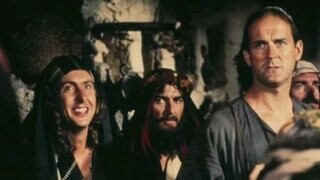4 Comedies That Had the Courage to Take Huge Risks

Plenty are content to play things safe in the world of comedy by, say, lobbing insults at old movies alongside robot puppet sidekicks. But occasionally, movie and television comedies have had the conviction to take some pretty huge risks — like even bigger than the risk that viewers will angrily whip their remotes at the screen at the sight of Tim Allen. Here are some of the comedies that, in retrospect, took some shockingly big chances, such as how…
Click right here to get the best of Cracked sent to your inbox.
Charlie Chaplin Made ‘The Great Dictator’ Before the U.S. Entered World War II
Don't Miss
These days, it might seem like a total no-brainer that Charlie Chaplin lampooned Adolf Hitler in The Great Dictator since A) making fun of Hitler was a thing old-timey comedians did, and B) Chaplin presumably already had a bunch of those fake mustaches lying around.
But Chaplin’s movie was more daring than it might seem. You need to understand the production’s timeline: He began filming The Great Dictator in September 1939, just days after the start of World War II. The U.S. famously didn’t enter the war until December 1941, following the surprise attack on Ben Affleck and Josh Hartnett. According to Chaplin’s autobiography, he was warned that the movie would “run into censorship trouble,” and English exhibitors were “very concerned about an anti-Hitler picture.” The studio, in fact, flat-out suggested that Chaplin not make the movie at all, “declaring it would never be shown in England or America.”
Of course, it was eventually released in 1940, and according to some reports, it would even be screened for Hitler himself.
‘South Park’ Made ‘Trapped in the Closet’ Specifically Because Networks Were Afraid of Lawsuits
There were a number of consequences to South Park’s landmark Scientology-skewering episode “Trapped in the Closet,” ranging from Isaac Hayes, Chef himself, quitting the show to the Church of Scientology hiring of private detectives to rummage through Trey Parker and Matt Stone’s garbage. Yes, apparently, real-life P.I. work sometimes involves less shooting bad guys and seducing femme fatales, and more examining snotty tissues belonging to the Orgazmo guys.
Parker and Stone were never actually sued by the Church of Scientology, despite the episode’s litigation-baiting ending.
But the possibility of a serious lawsuit wasn’t merely a hypothetical concern; it was the very reason why Parker and Stone decided to do the episode in the first place. According to Parker, they avoided the topic of Scientology in previous seasons due to their friendship with Hayes, but when another friend, Penn Jillette, informed them that Showtime had blocked a Scientology-themed episode of Penn & Teller: Bullshit! they decided to respond to this “fucked-up” decision by making their own show about Scientology. “Hearing other people say, ‘You can’t do that,’” Parker recalled, “You can only say ‘You can’t do that’ so many times to Matt and me before we’re gonna do it.”
George Harrison Mortgaged His House to Pay for ‘Life of Brian’ — Because No One Would Risk Financing It
Monty Python’s Life of Brian was obviously a controversial movie — although, to be fair, it could have been worse had they gone with the original pitch: Jesus Christ: Lust for Glory. Nowadays, it’s regarded as a comedy classic, but at the time, this was far from a guarantee. In other words, it was as sensible an investment as Kevin Spacey-branded NFTs.
Originally the film was going to be financed by EMI Films — until the head of the company read the script and was “appalled.” EMI pulled funding just two days before filming was set to begin. In a panic, Eric Idle called George Harrison for help, purely because he was “the richest person he knew.” But Harrison didn’t just have piles of Beatles cash lying around; in order to pay for the movie, he remortgaged his house, and his business manager remortgaged his office. While it paid off, this has to be the biggest gamble a Beatle took since someone said, “Why don’t we let Ringo sing?”
The Smothers Brothers Turned Their Variety Show into a Weekly Counterculture Protest
Popular comedy folk music duo The Smothers Brothers had a hit on their hands with the 1967 variety show The Smothers Brothers Comedy Hour, which featured both popular musical acts like The Who and old-school Hollywood stars like George Burns.
While the Smothers were originally an apolitical act and, therefore, a safe bet for the network, they began to introduce more and more political satire into the show. Eventually, they began hosting bold, countercultural statements; Harry Belafonte sang “Don’t Stop the Carnival” in front of footage of police brutality at the 1968 Democratic Convention in Chicago. Not only did CBS censor the segment, they “replaced it with a Nixon for President commercial.”
Another time, a sketch making fun of President Lyndon Johnson prompted LBJ to complain to the chairman of CBS. The Smothers agreed to “ease up” on the satire in exchange for permission to break the “17-year blacklist on folksinger Pete Seeger.” The network agreed, and Seeger performed “Waist Deep in the Big Muddy,” an “obvious allegory about the Vietnam War and Johnson himself.” It was cut from the broadcast, but CBS got so much bad press that they were forced to invite Seeger back on the show, at which point he performed the same song, this time for an even larger audience.
Ultimately, the Smothers Brothers were fired by CBS, and the show was canceled after three seasons, in spite of the fact that The Smothers Brothers Comedy Hour was one of the top 10 most popular shows in the country.
You (yes, you) should follow JM on Twitter (if it still exists by the time you’re reading this).